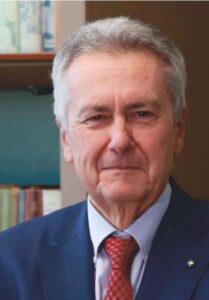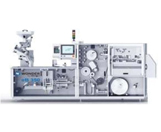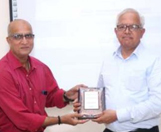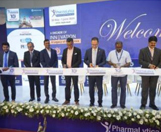Celebrating 50 years of innovatiosn at Achema 2024
 Achema 2024 was a special occasion for the Marchesini Group. This year, the group celebrated its 50th anniversary. In addition, it showcased a wide selection of machines and production lines for the pharmaceutical industry. The G3 stand in Hall 3.1 featured a range of pharma engineering solutions from various Group divisions, including an exciting new development to enhance the performance of companies specializing in injectable sterile medicines manufacturing. Highlights from the Pharma Packaging division included the new packaging and labeling line. The Digital area showcased the latest innovations in digital transformation and artificial intelligence, such as the “Morpheus” predictive maintenance solution, augmented reality format changeover, and cutting-edge robotic technologies.
Achema 2024 was a special occasion for the Marchesini Group. This year, the group celebrated its 50th anniversary. In addition, it showcased a wide selection of machines and production lines for the pharmaceutical industry. The G3 stand in Hall 3.1 featured a range of pharma engineering solutions from various Group divisions, including an exciting new development to enhance the performance of companies specializing in injectable sterile medicines manufacturing. Highlights from the Pharma Packaging division included the new packaging and labeling line. The Digital area showcased the latest innovations in digital transformation and artificial intelligence, such as the “Morpheus” predictive maintenance solution, augmented reality format changeover, and cutting-edge robotic technologies.
President Maurizio Marchesini
Marchesini Group closed 2023 with 591 million in revenue, marking a +15% increase compared to 2022. In 2024, the Group plans to consolidate its strategic assets, maintaining the same trend as the previous year and aiming for further growth. “To achieve these objectives and best prepare for the challenges, the Marchesini Group continuously invests in robotics, vision systems, and artificial intelligence.
Further speaking with Pharma Machines & Technology MAURIZIO MARCHESINI, PRESIDENT MARCHESINI GROUP, at Achema 2024, discuss “50 years of history with a constant focus on the future.”
1. Could you share with us the journey of Marchesini Group over the past 50 years and how the company has evolved in the pharmaceutical and biotechnological sectors?
Marchesini Group’s origins date back 50 years to a small garage in the Apennines near Bologna. Massimo Marchesini was a young, specialised technician working for a major packaging company at that time. His ingenuity and passion drove him to take up the challenge of creating something new. Working with visionary designer Giuseppe Monti, a former motorcycle technician, and a group of other enterprising young individuals, Marchesini laid the foundations for developing innovative projects for the packaging industry. In 1974, the 2M was launched. This was the era of prototypes, such as the first intermittent cartoner, followed by the first sachet powder packaging machine and the first tube-filling machine for effervescent tablets in rigid tubes. In the 1980s, the BA 400 was launched: a continuous cartoner with the magazine positioned at the bottom, facilitating machine operation for the user. Over time, the initial team worked on advanced technology and and created demand in the industry. In 1989, the company consolidated as the Marchesini Group. In the 1990s and 2000s, the company focused on acquiring brands specialising in the packaging of specific products. It focused on internationalisation: production remained in Italy, but the logo and machines began to travel and enter the pharmaceutical and cosmetic industries worldwide.
2. What are some of the key milestones or achievements that Marchesini Group is most proud of during its 50 years in operation?
A significant milestone in these 50 years was the acquisition of CO.RI.M.A in 2008, a leading company in the Tuscan district renowned in Italy for its expertise in filling sterile products. This acquisition allowed the Marchesini Group to enter the sterile product market, enabling them to produce complete lines for packaging increasingly complex pharmaceutical products. Since then, they have intensified the production of innovative machines utilizing robotic solutions, which ensure maximum flexibility and precision in controlled contamination environments.
3. How does Marchesini Group ensure that its machines and production lines meet the rigorous Good Manufacturing Practice (GMP) standards?
This in-depth process began with the introduction of our first machinery in the pharmaceutical industry. Ongoing discussions with our customers and crucial developments over the years have established the core principles guiding our R&D and design intelligence. Even our standard equipment undergoes regular reviews and updates as needed. This fundamental principle remains central in the design of our most bespoke lines.
Ultimately, success can be achieved with the right cooperation and feedback from our clients across various departments, including quality, validation, production, and maintenance.
4. The Digital area at your stand features advancements in artificial intelligence and digital transformation. Could you discuss the impact of these technologies on Marchesini Group’s operations and the pharmaceutical industry as a whole?
This is an area with massive potential. We have already developed successful AI-based products, such as vision systems for robotic solutions and product defect detection, just to mention two of the most relevant ones. Additionally, in diagnostic and predictive maintenance, the integration of digital features and artificial intelligence is providing us and our clients with more options for remote and preventive services.
5. With a global presence in over 116 countries, how does Marchesini Group adapt its innovations to meet diverse market needs and regulatory requirements?
While equipment design offers significant advantages, pharmaceutical requirements are generally standard worldwide. Therefore, having a global market presence is crucial. This enables us to stay informed about local trends and necessities, understand requirements, and manage projects with a consistent understanding of customers’ mentalities and ways of working.
6. Looking ahead, what are Marchesini Group’s plans for future growth and expansion, particularly in emerging markets like South America, Asia, and North Africa?
We are investing in and strengthening our local teams for both sales and after-sales resources. We have established Marchesini branches in Brazil, Mexico, Colombia, and Thailand.
Local presence for services and support in sales and after-sales is a key area for success in these emerging markets, and fortunately, we have good agencies. Our references and reputation give us a very strong foundation.
7. How does Marchesini Group integrate sustainability practices into its manufacturing processes and product development strategies?
We are implementing our portfolio of recyclable solutions, which will enable customers to meet the goals of the EU Plastics Strategy and national laws deriving from that place, whereby all packaging placed onto the EU market by 2030 shall be either reusable, recyclable, or compostable. In particular, Marchesini Group has been developing paperboard tray solutions for over 15 years. These solutions are an excellent alternative to plastic, reducing logistics and storage costs by up to 50%. They protect fragile products like syringes and vials, lowering operating costs and floor space while improving efficiency. Our Group customizes trays and cartons for specific products, using prototypes to optimize the packaging line. Robotics play a crucial role in handling and product insertion, allowing cardboard to replicate plastic shapes and sizes.
Articles
By Rameshwar Verma
An Interview with
President Maurizio Marchesini
Embracing Digital Innovations and Sustainable Practices Amidst Regulatory Pressures
An Interview with
Avinash Kumar Talwar







